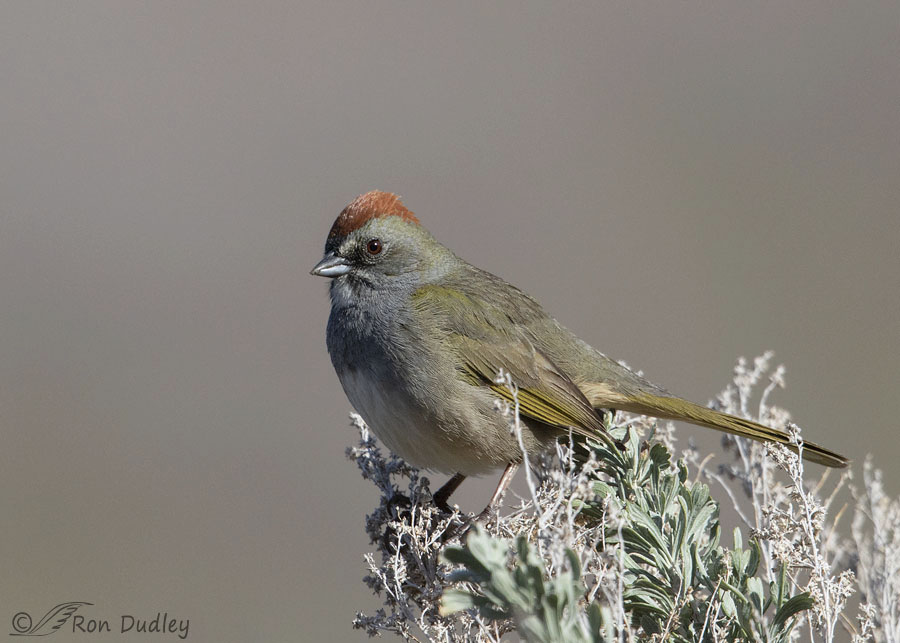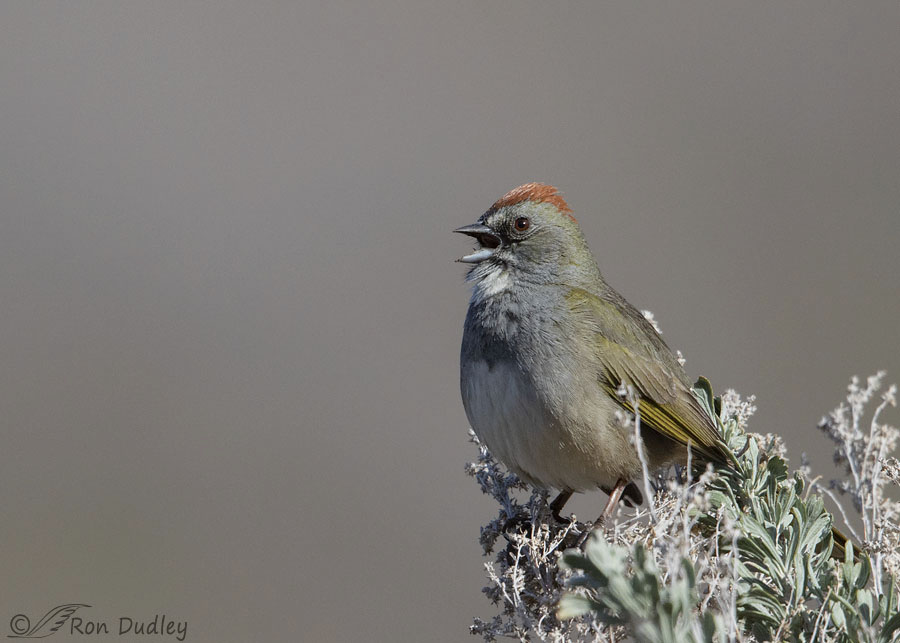The Green-tailed Towhee is understudied and remains one of North America’s least well-known birds. So my history with it is more than a little ironic.

1/3200, f/6.3, ISO 800, Canon 7D Mark II, Canon EF 500mm f/4L IS II USM + EF 1.4 III Extender, not baited, set up or called in
I photographed this male (only males sing and this guy was singing his heart out much of the time) yesterday morning in the mountains near Salt Lake City. Migrant bird activity in the mountains is still a little slow and finding him kept me from being bird-skunked.
In this pose we get a pretty good look at his namesake green tail but just before he began to sing consistently he…

1/4000, f/5.6, ISO 800, Canon 7D Mark II, Canon EF 500mm f/4L IS II USM + EF 1.4 III Extender, not baited, set up or called in
hid his tail from me.
Their secretive and elusive tendencies are one of the primary reasons so little is known about their life history and ecology but once males begin singing on territory they tend to be much more “sticky.” Their singing bouts typically range from 8 -15 minutes and can be as long as 27 minutes and this one performed for me for quite a while. Here’s a link to a video of a singing male if you have the interest.
In 1969 when I was a senior at the University of Utah I took an Ornithology class from the legendary Dr. William H. Behle and my field study species for that class was the Green-tailed Towhee. In my ignorance I had chosen one of the most difficult to study birds in North America and I remember well the challenges of finding them and then getting close enough to make any meaningful observations.
But I enjoyed my time in the field with them so much that I became hooked on birds and here I am today 50 years later, still obsessed by them.
And that’s why I call the Green-tailed Towhee my “spark bird”.
Ron
Notes:
- In the interest of full disclosure, in both photos above I removed a couple of bits of pokey-up sagebrush at the bottom of the frame. I don’t do that often but when I do I always disclose.
- Dr. Behle was the epitome of nerdy bird-obsession (which I actually admired). Once I was sitting in his class when a teaching assistant came up and whispered something in his ear. In a flash he left the classroom with no explanation to anyone. Turns out someone had reported a rare bird near the Great Salt Lake and Behle just had to investigate.


Dr. Behel is my hero then. For getting you hooked AND for dashing out of class for a rare bird sighting. 😀
Lovely subtle colours, yes my viewing is distorted between the two eyes, and not 20/20 but without the cataract, I see something like a RAW photo heightened by vibrance, contrast, saturation and clarity.I enjoyed the story about Dr. Behle leaving the class to investigate.
Ron, I’m very late to the party. I have songbirds that sing melodious songs in my back yard. I am not able to see the bird amongst my many trees but the songs are wonderful. I listened to your link and enjoyed it a great deal. Thank you for the link to the bird singing. So enjoyable.
What a handsome bird. Love the coloring. I have read where we have them here, but I have yet to see one. I do see the California Towhee. Pretty bird, but not as striking as the Green Tailed. Thanks for the video.
We’re even, Jean. I’ve never seen a California Towhee, at least not that I remember.
I am soooo glad that the spark was ignited. It may have been accidental to begin with, but you have stayed in the high degree of difficulty birds, as well as staying with the birds themselves.
Love that energetic song too.
Thanks very much, EC.
I have one in my yard again the last few days. I have tried to get a photo but he is too wary. Good teachers can change your life. I bet you changed a few also.
I hope I did, April. Good luck with your towhee.
Thanks for the link to his song. And of course thanks for your photograph. Diana
You’re very welcome, Diana.
Sounds like the TA either had it in for you or knew you were up to the challenge. I prefer the latter explanation. 🙂 I love the story of Dr. Behle leaving the class for a bird sighting — that’s dedication to your life’s work! (And much better than one of my profs who was having a bad day and came into class, told all 200 of us off, and stormed back to his lab.)
Beautiful shots, even with the hidden tail. Thank you for including the video link. What a delightful song!
Probably the former, Marty. Don’t think he knew me well enough to know what I might (or might not) be capable of.
Your comment about your prof brought back a sad memory for me. My professor in my botany class was a really nice old man and one day we all sat in class waiting patiently for him to show up. Eventually a TA came in and told us that he had died during the night. Believe it or not that botany professor’s name was Dr. Seville Flowers.
And in another stretch of what’s believable, the following memorial to Dr. Flowers was written by my Ornithology professor Dr. Behle!
https://scholarsarchive.byu.edu/cgi/viewcontent.cgi?article=2689&context=gbn
Wow! What a fascinating man! And Dr. Behle wrote such a wonderful tribute. I’ve always had a soft spot in my heart for bryophytes and lichens — not sure why, but I find myself drawn to them whenever I come across them.
As for another coincidence, Dr. Flowers spent his early childhood less than 5 miles from where I live.
Sounds like you slogged through the entire thing, Marty. If so I admire your sticktoitiveness.
It was really interesting! Something about the style of writing and the subject matter made me think of simpler times and took me back to wandering the mountains with my dad.
Seems like you could also call this your nostalgia bird as I imagine it evokes a memory train of thought whenever you see it. Nice story and photos.
It sure does, Lyle. When I’m shooting in the mountains and on my way to my destination I can often look down on the little valley where my study area was. That valley is now flooded by a reservoir.
Nostalgia indeed.
Wonderful Ron!
Charlotte
Thanks, Charlotte.
Ron,
Beautiful. From the looks of his perch I thought you were going to say Antelope Island. Does the Towhee favor the canyons?
I had the highlight of my surgical recovery the other day as I was restricted to my back yard to watch birds come to my feeders: a Bullock’s Oriole flew in in all its orange glory… and stayed for quite some time. All my shots would be classified as “baited” but he was still beautiful. He has been there for several days straight now. So recovery isn’t as bad as I thought it would be.
Thanks for the pics of the great outdoors.
Stephen
They favor thick, shrubby habitats, Stephen. Typically I see them in relatively low elevation mountain canyons.
Yes, Bullock’s Orioles would be wonderful therapy during surgery recovery.
These photos are lovely, Ron. And thanks for including the link to the singing green-tailed towhee.
You’re welcome, Nancy. Thank you.
“Different” color combination that would be hard to spot…… Good photos of the bird! 🙂 The assistant probably DID know you had your work cut out for you and needed it! 😉 It would either turn you off entirely or turn you on………:) Glad it was the latter….. 🙂 “Mystery time” here – about 10 what appear to be GHO wing primaries on the ground between 2 trees near the house along with a couple of very small ones. Some broken off, some chewed at the base and either pulled or broken and one appears to have some flesh attached. No sign of the owl or that it got hung up in the tree above….. Can’t imagine it could fly well with all those missing!
Hard to spot is right, Judy. And yes, it’s my guess that the TA knew full well the implications of his suggestion for me to study this species.
Too bad about your owl. I hope it survived.
Beautiful bird and photos Ron. Neat that you did get the tail in the one. Have never seen this elusive guy other than in your post.
Everett Sanborn, Prescott AZ
Everett, I see them at a distance fairly often and hear them more often than that but getting close enough for decent photos is another story altogether. I fully understand why they’re so difficult to study.
I had never heard of this bird until you and Mia mentioned them in your blogs. How could such a beautiful bird be so overlooked? Both photos are beautiful. Such a lovely combination with the rufous cap and green tail…I’m sure it is a bird on every birder’s list to scout out. His song is distinctive enough so it certainly would draw you in if you heard it out in nature…once you hear it you know who’s singing. A bird to study for sure and I know we don’t get them here.
Thanks, Kathy. I don’t think researchers deliberately overlook them. It’s just that they’re so hard to study we still don’t know much about them.
I chose the Green-tailed Towhee as my study species at the suggestion of one of the teaching assistants of the class. I often wonder if he know (he probably did) that I really had my work cut out for me. I was of course ignorant of that fact but I soon found out…